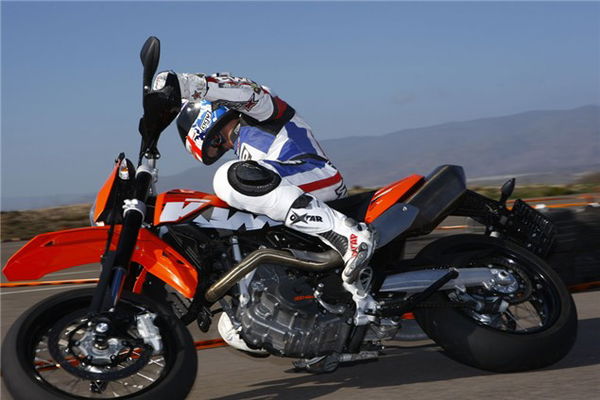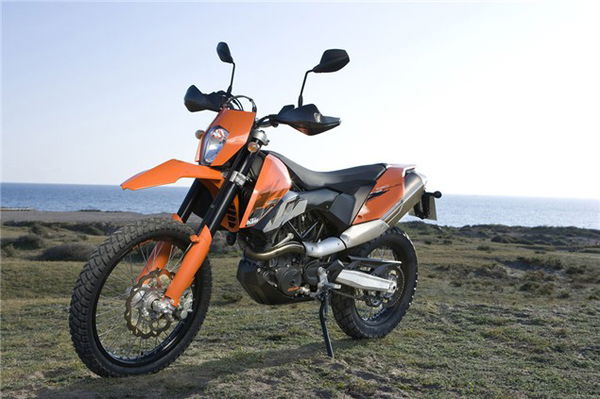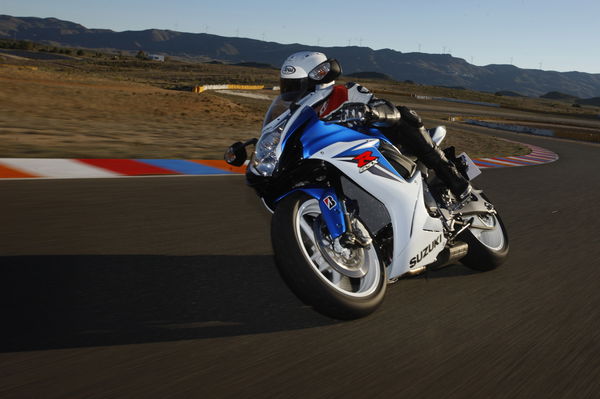First Ride: KTM 690 Enduro & SMC
These two bikes have a lot more in common than just the motor and are a much nearer to being able to live up to their name than any other street-moto or street-enduro machines currently on the market


690 SMC
The SMC, or ‘supermoto competition’ is basically the same bike as the Enduro. The only major differences being the wheels, brakes, gearing and the forks. The wheels are 17 inch spoked and fitted with sports road tyres, the front brake matches a 320mm floating disc to a four-pot Brembo caliper and the forks have a beefier, centrally mounted front axle and, strangely, 25mm more travel than the enduro variant. Everything else, the tank/airbox layout, 63bhp motor, multi-function digital dash and bodywork are the same as fitted to it’s off-road brother, although it feels lower to sit on because of the smaller diameter wheels.
After I’d got round the first couple of roundabouts heading for some twisty mountain roads I felt at home on this bike. There’s something about the combination of the long travel suspension, super-sticky Supercorsa Pro tyres, the wide bars and the general balance of the bike that give you confidence straight away. On the right bit of tarmac, and by that I mean the twistier the better, you’d struggle not to have fun on one of these little rascals.
The motor is at its best with the power switch locked on ‘aggressive’ (more on this later). Accelerating hard out of a 2nd or 3rd gear corner as you hook through the box it feels kind of raw, but not brutish. The way it pulls like a bull in the mid-range but is also happy to rev on to the 8,000rpm limit makes it feel more like a twin than a single. And it’s also the easiest bike to wheelie I’ve ever ridden, if that‘s what flicks your switch. On a modern sports bike, especially a one litre one, it’s easy to feel like your brain is one step behind what the bike’s doing. Somehow on the SMC you just feel in control. Not over faced with power, ’on top of the job’ as my dad would’ve said.
The only things I could find to have a little moan about were the slipper clutch (fitted to all three bikes) that was fairly ineffectual, in fact to be honest I couldn’t really tell it had one. Also the long 270mm travel suspension boinged around a bit on the really fast corners or loading and unloading when you changed direction quickly. Apart from that the SMC is a little belter as far as I’m concerned and I enjoyed pretty much every minute I spent on it. Sure you wouldn’t want to be doing big miles on one, but that wasn’t what they were designed for. As far as I can see they were designed for having fun with, and for that it was hard to fault.
690 Enduro
With the 690 Enduro KTM wanted to create a bike that bridged the gap between their successful range of pure competition enduro machines, like the 450 EXC for example, and the softer, bigger, road-going-only Japanese trailies like the Yamaha XT660R or the Suzuki DL650 V-Strom. But instead of just beefing up one of their existing four stroke enduro machines to accept the LC4 motor they went for a new design incorporating some innovative features.
The frame is a steel trellis type that uses the engine as a stressed member. The cylinder and cylinder-head assembly nestles up inside the frame tubes making for a very compact chassis and engine unit. To make the bike more usable off-road the engineers had to keep the overall weight down as much as possible and move the centre of gravity back. To achieve this the 12 litre re-enforced plastic fuel tank forms a monocoque rear sub-frame that also mounts the seat, battery and silencer, effectively doing away with the need for any rear frame tubes all-together. Above the engine (where you would expect to find the fuel tank on a more conventional layout) sits the air-box. Heavier stuff towards the back, lighter stuff nearer the front. Simple! In fact 53% of the bike’s mass sits on the rear wheel compared to about 48% on most road bikes, and that’s with an empty tank. With fuel it’d be even more tail heavy. To say this bike wheelies is an understatement.
The engine features a 3-way mapping switch allowing you to select between a ‘soft’ setting that reduces power by about 30% across the whole rev range, a ‘standard’ setting that gives full power with a progressive feel, and an ‘aggressive’ position where the power comes in with more of a bang in the mid-range. The switch is quite fiddly and to get to it you need to remove the seat, so it’s impossible to change settings on the fly. KTM say this is because the engine must be stopped for the ECU to reset itself, but I still think they could’ve made it easier. A switch in a more accessible position but one operated by the ignition key for example. Anyway, I tried all three power settings and found that the soft setting just made the bike feel slow, standard was best for finding traction on the dirt and aggressive was most fun on the road. And let me tell ya, 63bhp feels like plenty on gravel and provides more than enough thrills!
The wider ratio gearbox, street legal enduro tyres (as opposed to knobblies) and the fact that the motor is fitted with a balance shaft make this bike infinitely more usable and refined on the tarmac than a competition enduro machine would be. The motor pulls strongly from less than 3,000rpm and if your neck will stand it it’ll do about 110mph on the straight bits. The riding position was dead comfy and the bars could be moved forward to suit a bigger rider.
Once we got onto the dirt you could feel that this was a dual purpose bike. A claimed weight of 138kg is very light for this type of machine but it’s still 30kg or so heavier than a pure off roader, and you can tell. If you came to any really gnarly sections it felt quite big and first gear was too high to be able to keep any momentum going and you had to slip the clutch. Apparently 1st gear needs to be high to pass strict European homologation ‘drive-by’ noise regulations and KTM can easily supply different sprockets for you to retro-fit that’ll gear the bike down if you want to use it predominantly off road.
Also available is a pillion kit that includes a grab-rail, rear foot rests and a number of other after-market parts like Akrapovic exhausts and anodised billet yokes if you feel the need to pimp yer ride. Standard fit suspension is WP all round, as you’d expect seeing as KTM own WP. Getting a set-up that suits should be no problem with the units both front and rear being adjustable in every respect, although I found standard settings more than adequate for what we did.
Overall this bike was loads of fun on the street and just as well suited to the fairly flat dusty gravel tracks that our guide led us down in the south of Spain. Tackling a peat bog in the pissing rain on a Yorkshire hillside though I’m not sure would be quite so much fun. Having said all that I once came across a bloke trying to wrestle a DR600 Suzuki through a boggy Welsh forest, akin to attempting the Paris-Dakar in a Toyota Yaris, and he said he was having fun!
The Enduro would make a great town bike that you could venture onto the green lane without any trouble at all. As a genuine dual purpose bike you won’t find better, but if you’ve ridden pure off-road competition bikes you’d probably find it a bit ’portly’ on the dirt, and lacking a little suspension travel, especially if conditions got tough.
KTM 690SMC (& Enduro)
Price: £6,195 (£5,895)
Engine: 654cc, liquid-cooled, DOHC, 4-valve single
Power: 63bhp@ 7,500rpm
Torque: 49.4lb.ft@ 7,750rpm
Front suspension: WP 48mm USD, fully adjustable
Rear suspension: WP monoshock, fully adjustable
Front brake: 320mm discs, four-piston caliper. (300mm, two-piston)
Rear brake: 240mm disc, single-piston caliper
Dry weight: 139.5kg (138.5mm) (claimed)
Seat height: 900mm (910mm)
Fuel capacity: 12l
Top speed: 110mph (est)
Colours: Orange












